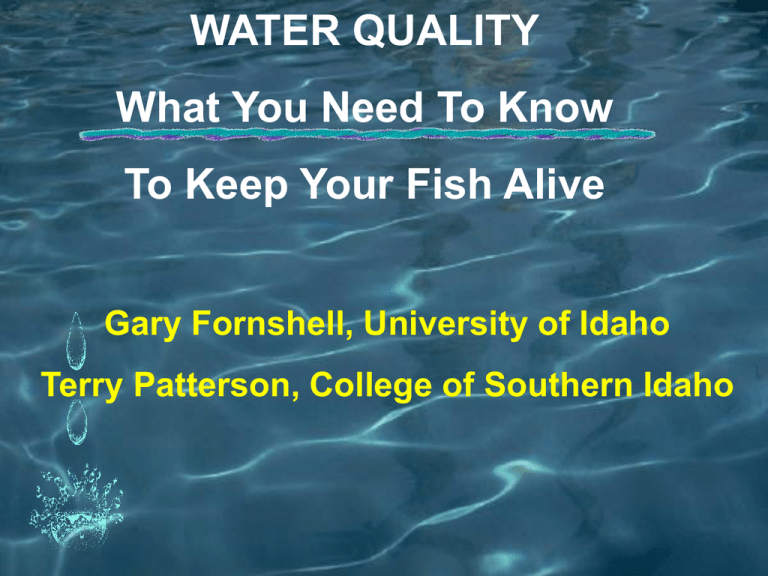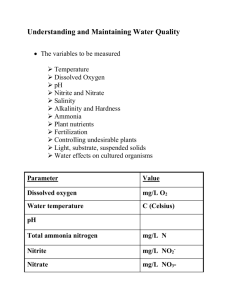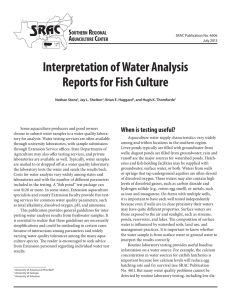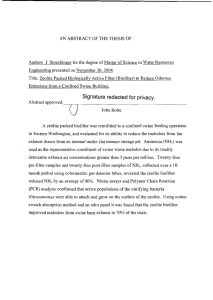Water Quality Power Point
advertisement

WATER QUALITY What You Need To Know To Keep Your Fish Alive Gary Fornshell, University of Idaho Terry Patterson, College of Southern Idaho To a great extent, the success or failure of fish culture is determined by water quality Water Quality – Why Is It Important? • Your fish live in it • Are supported by it • Receive their oxygen from it • And excrete in it Water Quality – Why Is It Important? • Water quality factors influence and interact with each other • What may cause problems in one situation may be harmless in another • Influences effectiveness/toxicity of treatments Water Quality – Why Is It Important? • Most disease problems can be avoided with proper management of water quality • This includes maintaining water quality at a level that provides an environment conducive to fish health and growth Water Quality Variables • Temperature • Dissolved oxygen • Total ammonia-nitrogen, NH3, NO-2 • Alkalinity • Hardness • pH • Carbon dioxide Water Quality Variables Temperature • For each 10°C (18°F) rise in temperature the metabolic rate doubles • Controls the reaction rate of chemicals • Influences solubility of gases in water • Influences toxicity of ammonia and therapeutants • Optimum temperature for tilapia growth is 85-88 °F Water Quality Variables Dissolved Oxygen • First limiting factor for growth and fish health • Solubility decreases with increasing temperature and elevation • Respiratory rate increases with increasing temperature, activity and feeding • In general the minimum DO should be ≥ 60% of saturation or ≥ 5 ppm (mg/L) • > 2 ppm in biofilter effluent Water Quality Variables Total Ammonia-Nitrogen • Usually the second limiting factor – nitrogenous waste: feces & feed •TAN includes ammonium ion (NH4+) and ammonia (NH3) • The proportion of NH3 increases with increasing temperature and pH • < 0.05 mg/L NH3 • < 0.5 mg/L nitrite-N (NO-2) , Percent of Total Ammonia in the Un-Ionized Form at Various Temperatures and pH percent Ammonia Temperature (ºF) (pH) 7.0 8.0 9.0 ___________________________________________ 50º 0.19 1.83 15.7 68º 0.40 3.82 28.4 86º 0.80 7.46 44.6 The Nitrogen Cycle Water plants Food Excess food Algae Nitrate (NO 3 ) Fishes Urine Feces Urea Nitrite (NO 2 ) Ammonia (NH 3 ) Peptides Amino acids Time Required for Bio-Filter to Mature 0.8 8 NO 3 0.6 Ammonia (mg/l) NH 3 NO2 6 0.4 4 0.2 2 0.0 0 2 6 10 14 18 Time in Days 22 Nitrites & Nitrates (mg/l) Water Quality Variables - Alkalinity • Is the buffering capacity of water – absorbs acids and/or bases • High alkalinity prevents wide pH fluctuations • Maintain levels between 75-120 mg/L as CaCO3 • 7 grams of alkalinity consumed by 1 gram of NH3 Effects of pH on Various Buffers Percent of Total CO 2 100 - Free CO 2 = HCO3 CO 3 50 0 4 5 6 7 8 pH 9 10 11 12 Water Quality Variables • Hardness 50 – 100 mg/L as CaCO3 • pH 7–8 • Carbon dioxide < 20 mg/L Water Quality Variables Total Dissolved Gases Supersaturation caused by: • leaking water lines • air leak on low pressure side of pump • source of water • mixing cold and hot water Recommended total dissolved gas pressure <104% Water Balance in Freshwater Fish Water Salts Ammonia Large quantities of dilute urine Stressors • Poor water quality • Environmental conditions • Improper handling Most Fish Diseases Are Stressed Mediated Stress is a physiologic state caused by a procedure, environmental condition or other factor which interferes with the fish’s ability to maintain a “normal” state. It extends the adaptive responses of an animal beyond the normal range or which disturbs the normal functioning. Low Level Mortality 100% Peracute M O Acute R T A L Chronic I T Y 0% Time Usually the first sign of water quality/environmental problems Loading Effects Number of fish which can successfully live and grow in a given amount of water depends on: • DO level • Metabolic rate of the fish • Amount being fed • Pathogen load • Water exchange rate Management Recommendations • Maintain water quality within suggested guidelines • Maintain fish loadings at optimum levels of 1/4 to 1/3 lb./gallon (1/2 lb./gallon maximum) • Monitor water quality on a regular basis/keep good records Management Recommendations • Low DO: increase aeration; stop feeding • High CO2: increase aeration; add air stripping column • Low pH: add sodium bicarbonate; reduce feeding rate; check ammonia & nitrite • High NH3: exchange system water; reduce feeding rate; check biofilter, pH, alkalinity & DO in biofilter • High nitrite: exchange water; reduce feed; add 6 ppm chloride per 1 ppm nitrite; check biofilter, pH, alkalinity & DO in biofilter Good Stuff To Know • ~ 300 square feet biofilter material per 100 lbs. fish • Add 0.125 to 0.167 lbs. baking soda/ 100 gallons to maintain alkalinity • Add 0.275 to 0.413 lbs salt/100 gallons to maintain chloride levels of 200 – 300 ppm • Do not make any rapid changes to any WQ parameter, except to increase DO Resources • SRAC Publications: http://www.msstate.edu/dept/srac/publicat.htm • Hach WQ test kits: http://www.hach.com/ • LaMotte WQ test kits: http://www.lamotte.com/ • Equipment Suppliers: • http://aquaticeco.com/ • http://www.tecinfo.com/~aqcenter/ • Eagar, Inc. 1-800-423-6249






